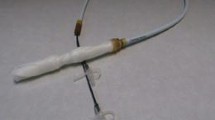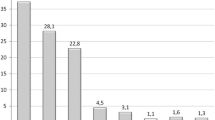Abstract
Background
We introduced intragastric balloon placement in Japan and evaluated the initial data.
Methods
Between December 2004 and March 2008, intragastric balloons [BioEnterics® Intragastric Balloon (BIB®) system] were placed in 21 Japanese patients with obesity [six women, 15 men; mean age 40 ± 9 years; mean body mass index (BMI) 40 ± 9 kg/m2]. The inclusion criteria were morbid obesity (BMI ≥ 35 kg/m2), the presence of obesity-related disorders, and failure with conventional treatments for at least 6 months. The balloon was routinely removed under endoscopy after 5 months.
Results
No serious complications occurred, but in two of the 21 patients (9.5%), early removal (within 1 week) of the balloon was required due to continuous abdominal discomfort. Two other patients (9.5%) could not control their eating behavior and were considered unresponsive to the treatment, and their balloons were also removed before 5 months. Seventeen of the 21 patients (81%) finished the treatment, and the average weight loss and percent excess weight loss (%EWL) at the time the balloons were removed were 12 ± 5 kg and 27 ± 9%, respectively. Eight patients were followed for 1 year without intervention of consecutive bariatric surgery, and at that time, four of these patients had kept more than 20% of %EWL. The other patients regained their weight in the first year.
Conclusions
Intragastric balloon placement is a safe and effective procedure in obese Japanese patients, and about half of the patients will maintain their weight loss after the balloon is removed.

Similar content being viewed by others
References
The Examination Committee of Criteria for ‘Obesity Disease’ in Japan, Japan Society for the Study of Obesity. New criteria for ‘obesity disease’ in Japan. Circ J. 2002;66:987–92.
Ministry of Health, Labour and Welfare of Japan. The national health and nutrition survey in Japan, 2003 (in Japanese). Tokyo: Dai-ichi Shuppan Publishing Co. Ltd.; 2006.
Lee WJ, Wang W. Bariatric surgery: Asia-Pacific perspective. Obes Surg. 2005;15:751–7.
Kitano S, Shiromizu A, Ohta M, et al. Intragastric balloon therapy for the treatment-resistant obesity (in Japanese). Gastroenterol Endosc. 2005;47:2197–201.
Fujimoto K, Sakata T, Etou H, et al. Charting of daily weight pattern reinforces maintenance of weight reduction in moderately obese patients. Am J Med Sci. 1992;303:145–50.
Tokunaga K, Matsuzawa Y, Kotani K, et al. Ideal body weight estimated from the body mass index with lowest morbidity. Int J Obes. 1991;15:1–5.
Deitel M, Gawdat K, Melissas J. Reporting weight loss 2007. Obes Surg. 2007;17:565–8.
Lee JS, Kawakubo K, Mori K, et al. Effective cut-off values of waist circumference to detect the clustering of cardiovascular risk factors of metabolic syndrome in Japanese men and women. Diab Vasc Dis Res. 2007;4:340–5.
Nieben OG, Haboe H. Intragastric balloon as an artificial bezoar for treatment of obesity. Lancet. 1982;1:198–9.
Roman S, Napoleon B, Mion F, et al. Intragastric balloon for “non-morbid” obesity: a retrospective evaluation of tolerance and efficacy. Obes Surg. 2004;14:539–44.
Galloro G, DePalma GD, Catanzano C, et al. Preliminary endoscopic technical report of a new silicone intragastric balloon in the treatment of morbid obesity. Obes Surg. 1999;9:68–71.
Totte E, Hendrickk L, Pauwels M, et al. Weight reduction by means of intragastric device: experience with the Bioenterics Intragastric Balloon. Obes Surg. 2001;11:519–23.
Sallet JA, Marchesini JB, Paiva DS, et al. Brazillian multicenter study of the intragastric balloon. Obes Surg. 2004;14:991–8.
Genco A, Bruni T, Doldi SB, et al. BioEnterics Intragastric Balloon: the Italian experience with 2,515 patients. Obes Surg. 2005;15:1161–4.
Mui WLM, So WY, Yau PYP, et al. Intragastric balloon in ethnic obese Chinese: initial experience. Obes Surg. 2006;16:308–11.
Ganesh R, Rao AD, Baladas HG, et al. The BioEnterics® Intragastric Balloon (BIB®) as a treatment for obesity: poor results in Asian patients. Singapore Med J. 2007;48:227–31.
Delgado-Aros S, Cremonini F, Castillo JE, et al. Independent influences of body mass and gastric volumes on satiation in humans. Gastroenterology. 2004;126:432–40.
Cendes A, Burgos AM. Size, volume and weight of the stomach in patients with morbid obesity compared to controls. Obes Surg. 2005;15:1133–6.
Puglisi F, Antonucci N, Capuano P, et al. Intragastric balloon and binge eating. Obes Surg. 2007;17:504–9.
Hamoui N, Kingsbury S, Anthone GJ, et al. Surgical treatment of morbid obesity in schizophrenic patients. Obes Surg. 2004;14:349–52.
Dixon JB, O’Brien PE. Selecting the optimal patient for LAP-BAND placement. Am J Surg. 2002;184:17S–20S.
der Goederen-van der Meij S, Pierik RGJM, Pool MO, et al. Six months of balloon treatment does not predict the success of gastric banding. Obes Surg. 2007;17:88–94.
Doldi SB, Micheletto G, Perrini MN, et al. Intragastric balloon: another option for treatment of obesity and morbid obesity. Hepato-Gastroenterology. 2004;51:294–7.
Herve J, Wahlen CH, Schaeken A, et al. What becomes of patients one year after the intragastric balloon has been removed? Obes Surg. 2005;15:864–70.
Mathus-Vliegen EMH, Tytgat GN. Intragastric balloon for treatment-resistant obesity: safety, tolerance, and efficacy of 1-year balloon treatment followed by a 1-year balloon-free follow-up. Gastrointest Endosc. 2005;61:19–27.
Melissas J, Mouzas J, Filis D, et al. The intragastric balloon—smoothing the path to bariatric surgery. Obes Surg. 2006;16:897–902.
Angrisani L, Lorenzo M, Borrelli V, et al. Is bariatric surgery necessary after intragastric baloon treatment? Obes Surg. 2006;16:1135–7.
Busetto L, Segato G, De Luca M, et al. Preoperative weight loss by intragastric balloon in super-obese patients treated with laparoscopic gastric banding: a case-control study. Obes Surg. 2004;14:671–6.
Frutos MD, Morales MD, Lujan J, et al. Intragastric balloon reduces liver volume in super-obese patients, facilitating subsequent laparoscopic gastric bypass. Obes Surg. 2007;17:150–4.
Acknowledgments
We thank Ms. Kazuyo Adachi and Yukiko Ishibashi for prescription and supervision of diet and Ms. Miho Sato and Midori Kono for patient management.
Author information
Authors and Affiliations
Corresponding author
Rights and permissions
About this article
Cite this article
Ohta, M., Kitano, S., Kai, S. et al. Initial Japanese Experience with Intragastric Balloon Placement. OBES SURG 19, 791–795 (2009). https://doi.org/10.1007/s11695-008-9612-x
Received:
Accepted:
Published:
Issue Date:
DOI: https://doi.org/10.1007/s11695-008-9612-x




